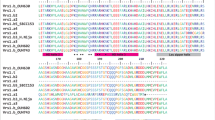Abstract
The origin of six-rowed cultivated barley has been revealed to be more complex since the discovery of agriocrithon, a six-rowed barley with brittle rachis. The present study investigates whether such six-rowed brittle barley is wild or hybrid in nature, by analyzing genetic diversity at the cMWG699 marker locus, which is closely linked to the vrs1 (six-row gene) locus. DNA sequence analysis for 42 accessions showed only three types in six-rowed brittle barleys; in contrast, nine sequence types were found in ten wild barleys, ssp. spontaneum, in our previous study. Nucleotide diversities for the six-rowed brittle barley were 2.8–4.5 times lower than that for the ssp. spontaneum at this marker locus. The three sequence types found in the six-rowed brittle barley also appeared in the six-rowed cultivated barley. A cross-allelism test confirmed that the six-rowed character of the six-rowed brittle barley was controlled by the vrs1 locus. The nucleotide diversity and genealogy demonstrated that f. agriocrithon does not have the same level of diversity as found in wild barley, ssp. spontaneum. Consequently, f. agriocrithon does not appear to represent genuinely wild populations, but more probably originated from hybridization between ssp. spontaneum and six-rowed cultivated barley.



Similar content being viewed by others
References
Åberg E (1938) Hordeum agriocrithon nova sp., a wild six-rowed barley. Ann Agric Coll Sweden 6:159–212
Åberg E (1940) The taxonomy and phylogeny of Hordeum L. Sect. Cerealia Ands. Symbolae Bot Upsalienses 4:1–156
Bothmer R von, Jacobsen N, Baden C, Jørgensen RB, Linde-Laursen I (1995) An ecogeological study of the genus Hordeum. Systematic and ecogeographic studies on crop genepools 7, 2nd edn. International Plant Genetic Resources Institute, Rome
Freisleben R (1940) Die phylogenetische Bedeutung asiatisher Gersten. Zuchter 12:257–272
Harlan JR (1995) Barley. In: Smartt J, Simmonds NW (eds) Evolution of crop plants, 2nd edn. Longman, London, pp 140–147
Komatsuda T, Li W, Takaiwa F, Oka S (1999) High resolution map around the vrs1 locus controlling two- and six-rowed spike in barley, Hordeum vulgare. Genome 42:248–253
Konishi T (2001) Genetic diversity in Hordeum agriocrithon E. Åberg, six-rowed barley with brittle rachis, from Tibet. Genet Res Crop Evol 48:27–34
Lundqvist U, Franckowiak J, Konishi T (1997) BGS6; six-rowed spike 1. Barley Genet Newsl 26:49–50
Nei M (1987) Molecular evolutionary genetics. Columbia University Press, New York
Posada D, Crandall KA (2001) Intraspecific gene genealogies: trees grafting into networks. Trends Ecol Evol 16:37–45
Rozas J, Rozas R (1999) DnaSP version 3: an integrated program for molecular population genetics and molecular evolution analysis. Bioinformatics 15:174–175
Shao Q, Li A (1987) Unity of genetic population for wild barley and cultivated barley in Himalaya area. In: Yasuda S, Konishi T (eds) Barley genetics V. Sanyo, Okayama, pp 35–41
Takahashi R (1955) The origin and evolution of cultivated barely. In: Demerec M (ed) Advances in genetics 7. Academic, New York, pp 227–266
Tanno K, Takaiwa F, Oka S, Komatsuda T (1999) A nucleotide sequence linked to the vrs1 locus for studies of differentiation in cultivated barley (Hordeum vulgare L.). Hereditas 130:77–82
Tanno K, Taketa S, Takeda K, Komatsuda T (2002) A DNA marker closely linked to the vrs1 locus (row type gene) indicates multiple origins of six-rowed cultivated barley (Hordeum vulgare L.). Theor Appl Genet 104:54–60
Watterson GA (1975) On the number of segregating sites in genetical models without recombination. Theor Popul Biol 7:256–276
Yin YQ, Ma DQ, Ding Y (2003) Analysis of genetic diversity of hordein in wild close relatives of barley from Tibet. Theor Appl Genet 107:837–842
Zhang Q, Yang GP, Dai X, Sun JZ (1994) A comparative analysis of genetic polymorphisms in wild and cultivated barley from Tibet using isozyme and ribosomal DNA markers. Genome 37:631–638
Zohary D (1959) Is Hordeum agriocrithon Åberg the ancestor of six-rowed cultivated barley? Evolution 13:279–280
Zohary D (1960) Studies on the origin of cultivated barley. Bull Res Counc Israel 9D:21–42
Zohary D (1963) Spontaneous brittle six-rowed barley, their nature and origin. Barley genetics I. In: Proceedings of the 1st international barley genetics symposium, Wageningen, pp 27–31
Acknowledgements
The author thanks Dr. G. Willcox, Institut de Préhistoire Orientale, Jalès, France, for his critical reading of the manuscript, and thanks also to Dr. K. Yamane, University of Kyoto, Japan, and Dr. K. Fukunaga, University of Renne, France, for their comments on the manuscript. This study was supported by the Japan Society for the Promotion of Science for Young Scientists.
Author information
Authors and Affiliations
Corresponding author
Additional information
Communicated by F. Salamini
Rights and permissions
About this article
Cite this article
Tanno, K., Takeda, K. On the origin of six-rowed barley with brittle rachis, agriocrithon [Hordeum vulgare ssp. vulgare f. agriocrithon (Åberg) Bowd.], based on a DNA marker closely linked to the vrs1 (six-row gene) locus. Theor Appl Genet 110, 145–150 (2004). https://doi.org/10.1007/s00122-004-1816-4
Received:
Accepted:
Published:
Issue Date:
DOI: https://doi.org/10.1007/s00122-004-1816-4




